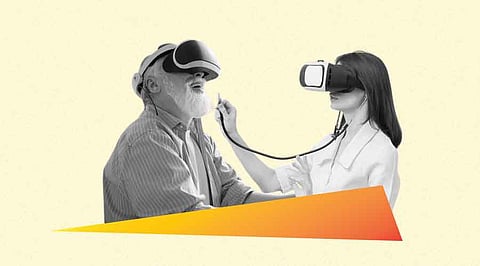

In the battle against severe illnesses and disorders, experts frequently turn to cutting-edge technology. Consequently, traditional therapy has been replaced with high-tech simulations. Nowadays, patients have hope for a partial or even full recovery thanks to the application of new technology, but in the past, many ailments and diagnoses sounded like a verdict.
Scientists started to get proficient with VR technology in medicine back in the early 1990s. Nearly 20 years ago, medical VR apps first became available. These included telepresence surgery solutions, rehabilitation apps, and surgical simulations. The Green Telepresence Surgery System, which comprised a surgeon's workstation and a remote worksite, was one of the earliest VR simulators built back in 1991. People might practice surgery with a scalpel and clamps on a simulated body by using these VR simulators. It was a significant advancement in surgeon capacity-building and medical education.
Virtual reality is becoming widely accepted as an essential component of many aspects of human existence, and multiple studies have confirmed that this is also the case in the medical field. Research and Markets' analysis indicates that by 2023, the virtual and augmented reality healthcare industry will be worth $5 billion. Experts predict that augmented and virtual reality technology will be extensively employed in patient consultations via remote consultation, diagnosis, and treatment and rehabilitation.
Virtual reality (VR) is not new to medicine today; in fact, an increasing number of medical specialties have shown that using VR apps to treat patients produces far better outcomes than using traditional therapy. Virtual reality has shown to be a handy tool for rehabilitation, and for good reason. Patients can enter an alternate reality where they can interact with objects and do activities that are not normally available to them in real life thanks to simulated virtual environments, objects, and events. This is one of the few, if not the only, means by which patients can "escape" the confining atmosphere of the hospital.
A patient should get training in an atmosphere that closely resembles the real world.
Timely feedback on the activities completed and progress made should be given to the patient. It will allow the patient to identify any errors and make necessary corrections before trying the exercise again until they achieve success.
A patient must be willing to learn new skills and participate in the process.
Providing the opportunity to use more sophisticated digital rehabilitation techniques in place of traditional therapy.
Maximizing the effectiveness of rehabilitation measures.
Using in individualized treatment plans created based on careful assessment and case-by-case treatment goals.
It helps analyze and better understand the needs of people with disabilities in public places and at home.
Allowing patients with various disorders to perform actions that they cannot function in real life due to their disabilities.
A next-generation 3D technology called CAREN offers those who have suffered severe injuries and are limited in their range of motion the opportunity to heal. This really innovative biomechanical virtual reality system is intended to aid in the recovery of severely wounded athletes and military people by assisting with the restoration of motor function, walking, posture, and balance, as well as the treatment of back pain brought on by various traumas. Most cutting-edge research facilities and clinics employ a combination of hardware and software tools, such as a motion base, motion capture, a projection screen, and the D-flow program, to train and assess patients' various motor skills. Depending on the unique requirements and objectives of patients undergoing rehabilitation, CAREN provides three default settings that can be further adjusted.
It is reasonable to say that the applications of virtual reality in medicine are virtually limitless. Architects are also utilizing virtual reality's capacity to design hospitals of the future. Operating rooms, intensive care units, wards, and extensive rehabilitation gyms, among other facilities, are all being tested in virtual reality before being built. Regarding the application of VR technology in rehabilitation, it is essential to remember that, similar to other high-tech techniques, virtual reality offers benefits and drawbacks as compared to conventional approaches to physical rehabilitation.
The high expense of the hardware and software needed to provide the illusion of complete immersion in a virtual environment is one of the apparent drawbacks of virtual reality. However, there are a lot of clear benefits of virtual reality, even with certain drawbacks. Compared to typical physical rehabilitation, the majority of patients receiving VR treatment had much higher levels of motivation. Patients might try on various roles and do acts that they would rarely be able to do in real life while undergoing rehabilitation sessions in virtual reality. Virtual reality apps used in rehabilitation processes help patients feel better emotionally, which is a significant benefit on the road to recovery.
Join our WhatsApp Channel to get the latest news, exclusives and videos on WhatsApp
_____________
Disclaimer: Analytics Insight does not provide financial advice or guidance on cryptocurrencies and stocks. Also note that the cryptocurrencies mentioned/listed on the website could potentially be scams, i.e. designed to induce you to invest financial resources that may be lost forever and not be recoverable once investments are made. This article is provided for informational purposes and does not constitute investment advice. You are responsible for conducting your own research (DYOR) before making any investments. Read more about the financial risks involved here.
